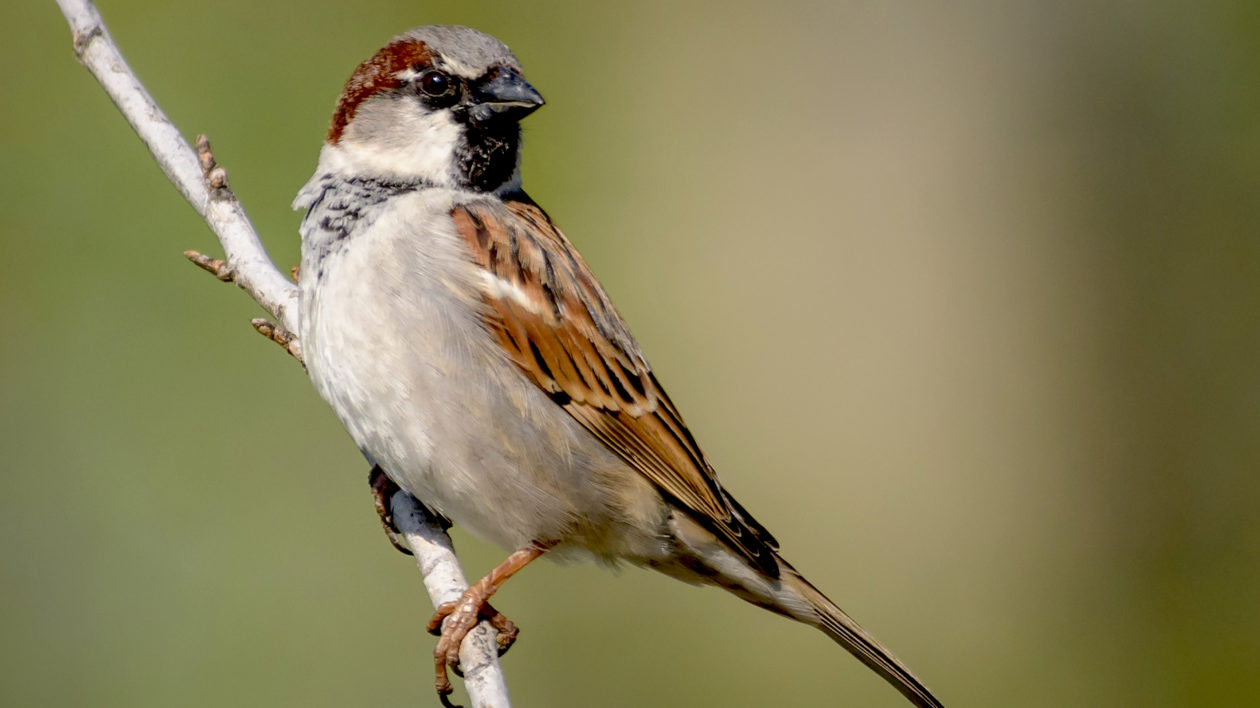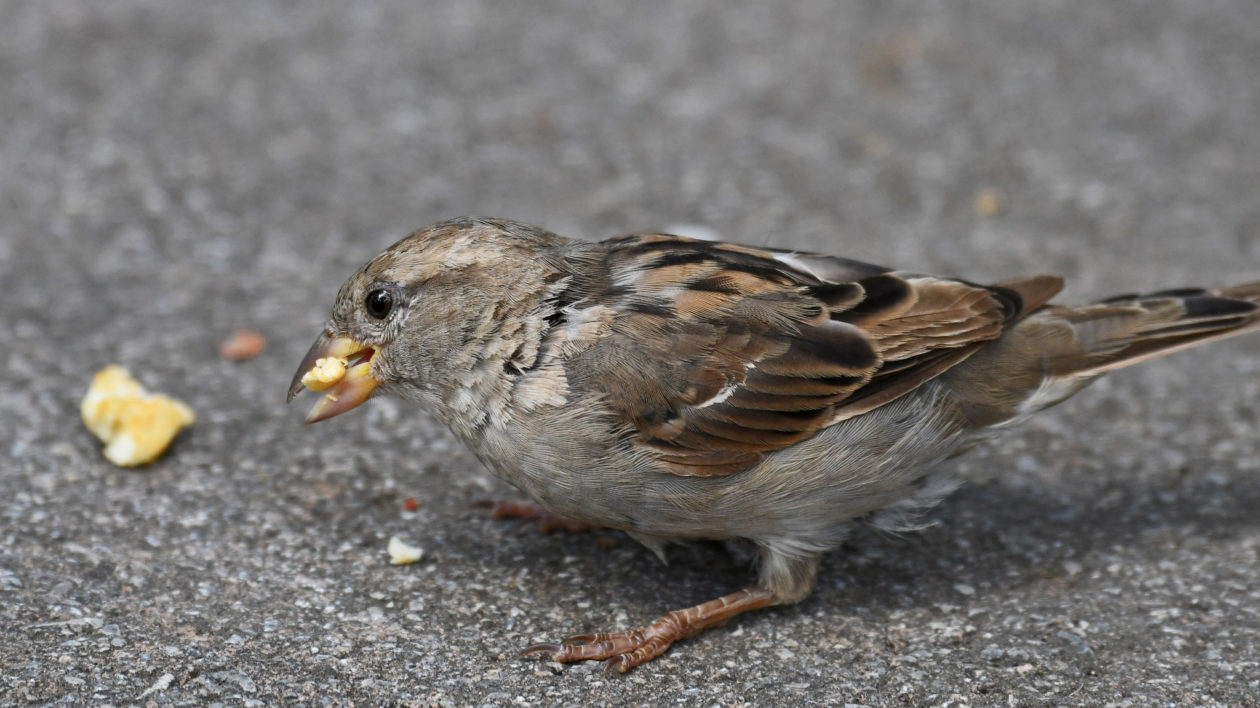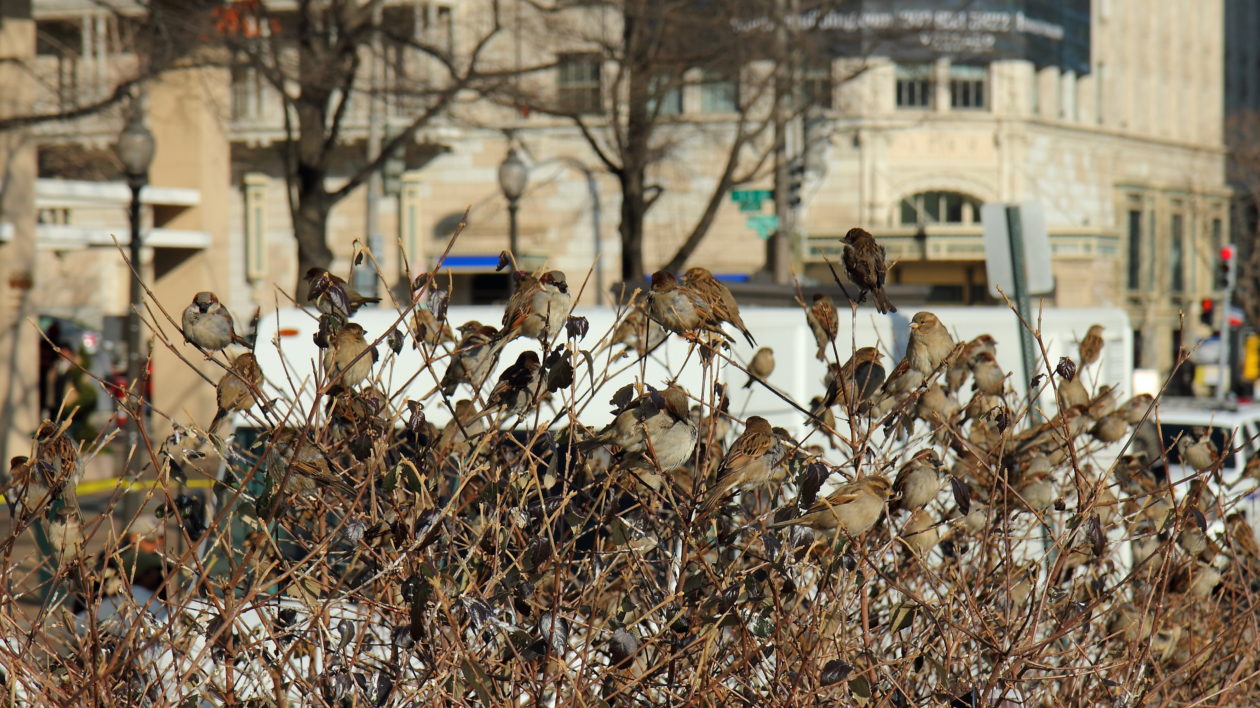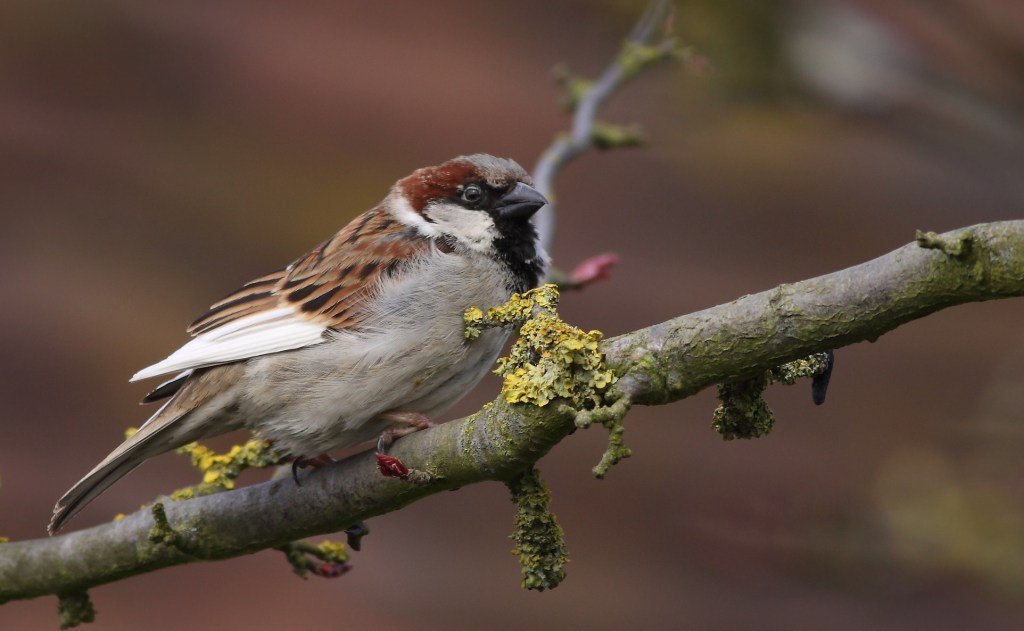I look out my window, and they’re everywhere: hundreds of house sparrows flit around our shrubs, hop around the yard, and steal food from our backyard chickens.
At this time of year, the males puff up and display, making them appear like much larger birds. They cheep incessantly, often drowning out other birdsong.
Given their constant presence, it seems odd to be writing this: House sparrow populations have been declining worldwide, including in their native range.
House sparrows are often considered one of the most adaptable birds, capable of thriving amongst our farms, suburbs and cities. The real story of their spread and decline is a bit more complex, and may have implications for urban conservation.
The Sparrow Fad
The house sparrow (Passer domesticus) is native to Eurasia, but beginning in the mid-1800s, it spread around the globe. Largely due to intentional releases by humans, house sparrows are now found on every continent except Antarctica, as well as many islands. It is the most widespread wild bird on earth.
As with many aspects of conservation history, many of the details of sparrow introductions are poorly documented. The first introduction to North America was to New York City in 1851 or 1852, although the 8 pairs released seemed to fare poorly. However, this set off a wave of introductions throughout the United States.
For a time, some sources refer to a “sparrow fad,” with private individuals breeding birds, and others catching them and releasing them into new areas. Nest boxes were installed in cities to increase sparrow populations. Ornithologists and others raised concerns over the merits of house sparrows, but their arguments proved futile against sparrow enthusiasts releasing cages full of birds.
The reason for many of these reasons was for pest control. For instance, their 1868 introduction to Philadelphia was apparently an effort to control inchworms. As with so many such pest control efforts, the cure proved worse than the disease. They thrive on a variety of foods, including spilled grain and even garbage.
The house sparrow is also an aggressive little bird. It nests in cavities, and pushed out native species like Eastern bluebirds. Backyard birders who erect birdhouses have undoubtedly noticed house sparrows bullying wrens and other native species.
Public sentiment turned quickly against the house sparrow. By the 1880s, just three decades after the first introduction, several U.S. cities paid bounties for the birds. But by then the bird was firmly established – and spreading.

Recent research published in the Proceedings of the Royal Society B found that house sparrows underwent genetic changes, including modified skull development and a gene that helps create the enzyme amylase that helps break down starch. The researchers hypothesized that these changes helped sparrows adapt to human settlements dominated by agricultural fields and livestock. The sparrows, according to the research, diverged from other Old World sparrows around 11,000 years ago, just as agriculture was taking hold in the Middle East.
The house sparrow appears to be a clear winner in the Anthropocene: an adaptable bird capable of thriving equally well on cities and in farms.
But over the past few decades, ornithologists have noted a new trend: house sparrows are in widespread decline. According to the Cornell Lab of Ornithology, house sparrow numbers in North America have declined by 84 percent since 1966. In Philadelphia, the city where the sparrows were introduced to control inchworms, the birds have largely disappeared.
Many birders view this as a good-news story. After all, house sparrows compete with native species and are generally viewed as a pest. However, the bird is experiencing similar declines in many parts of its native habitat, including the United Kingdom and Western Europe.
In England, house sparrow populations have declined by half. The species is listed by the Royal Society for the Protection of Birds as a species of high conservation concern. While the United Kingdom population has recently stabilized, the bird remains of concern to conservationists. European countries now recognize a World Sparrow Day to raise awareness of the plight of this once-abundant species.
What happened?

Sparrow Falling
Theories abound as to why house sparrows have declined. The answer likely lies in a combination of factors, all tied to rapid changes in both cities and farms. House sparrows may be highly adaptable, but that doesn’t mean they can thrive with every modification humans make to the environment.
The first house sparrow decline was actually reported in the 1920s, when automobiles began widely replacing horses. Sparrows feasted on the huge amount of spilled grain found in cities. When that food source was removed, sparrow populations decreased.
The Royal Society for the Protection of Birds and others note that changing agricultural practices likely play a significant role in the current sparrow decline. Once, farms were diverse, with crop fields and livestock barns scattered across the landscape. New, clean, intensified monocultures result in less spilled grain, and less cover around fields. In many parts of the world, other birds associated with farmland are also in decline.
Livestock is more frequently raised in confined operations, sometimes even indoors. All this results in fewer opportunities to feed on grain.
Similarly, city sanitary practices have improved, which may make finding meals more difficult for sparrows.
Research published in the journal Frontiers in Ecology and Evolution found that a combination of poor diet and air pollution induced physical stress on house sparrows, leading to reduced reproductive success.
The widely reported global insect decline may also be a significant factor. Many think of house sparrows as vegetarians, gobbling bird seed and grains. But, as with many birds, they rely on protein-rich insects to feed their young.

Implications for Urban Conservation
There are still 540 million house sparrows flying around the planet, so this bird is not in danger of going extinct. It’s still abundant in many places – including my neighborhood, where a mix of native vegetation, bird feeders and backyard chicken coops provide the diversity of habitat and food sources that enables these birds to thrive.
So why is the house sparrow decline important?
In part, it shows how little we understand urban ecology. Even conservationists often assume that common, adaptable species will be able to adapt to any change. That’s clearly not the case.
All ecosystems change, but human environments often change rapidly. If we’re thinking about protecting biodiversity in cities – and in a world that will have 9 billion people, we have to – we have to think about how changes impact wildlife. Just as modification to a tropical forest affects wildlife, so too do changes in farming practices, changes in city design, even changes in bird feeding habits.
I wouldn’t miss the house sparrow from my neighborhood. It’s an invasive species that competes with native birds. But globally, the sparrow’s decline is a story we should heed, as it may help us better understand how to coexist with nature in the Anthropocene.




I have a good flock of sparrows in the back garden which I feed , but for the last three weeks there has been nothing , a neighbour about two gardens away had a large fir tree cut down and the sparrows did roost in it at night , could that be the reason for the disappearance . I have two small trees at the bottom of the garden and the sparrows loved hanging out in them chirping and argueing with each other plus nest boxes dotted about which they nested in but now they’ve all gone what’s the answer.
I love seeing the sparrows but unfortunately they are a very rare sight in my garden now as it seems to be seagulls, magpies and crows and I fear for the little sparrow although I love the blue ties and the wrens that appear daily. Come on little sparrow come back to us.
We found that our sparrows disappeared about 3 weeks ago
This appears to have coincided with our neighbours spraying their house to remove spiders.
This is very sad as we enjoyed them filling the bushes.
Is this coming?
I’ve been wondering for a long time why these somewhat annoying feathered friends were declining. Thanks for informing me. House finches and blue birds are more welcome neighbors now. ?
I do not care for the English House Sparrow. When I was a boy they drove out the bluebirds near my home and bullied other small birds from the feeders. My father used to trap and hunt them. They were everywhere in town, under awnings and roof rafters, their bird dropping lining the sidewalks, making an unhealthy mess. However, I have noticed a big decline of their population here in Georgia. I do not see them in rural neighborhoods anymore–absolutely none whatsoever. The few that I still see, and even they have decreased, are in the towns. I don’t think there’s one easy explanation for their decline, but I do believe farming practices and the lack of spilled grain, grist mills, etc. have played a hand in it. The good side to this story, I have seen an upswing in the Bluebird population here in Georgia.
This article has no resolve. It doesn’t answer the question it raised.
If sparrows were to disappear from my city, I would miss them big deal; together with doves, pigeons and few other species, they are the only birds that have adapted to live in the cold, ugly and lifeless places we have built. Most other birds are disappearing as well, call them “invasive” or “native”, we are for a lifeless world, maybe not long into the future.
Recommended read:
Decline of the North American avifauna, Kenneth V. Rosenberg, October 2019, Science.
https://science.sciencemag.org/content/366/6461/120
In the book “The Invisible Rainbow, A History of Electricity and Life” Chapter 16 (Bees, Birds, Trees, and Humans pages 326-328) author Arthur Firstenberg references several studies showing the proliferation of cell phone towers and thus, increase in microwave radiation, particularly around urban parks, as a direct cause of the decline of House Sparrows in several urban areas around the world. Very alarming.
Hi Matthew,
Have you considered/researched the adverse effects of geoengineering, climate engineering and Solar Radiation Management (SRM) re decline in sparrow population? The effects of geoengineering activities are toxic to both humans and animals. This website has good information about geoengineering: https://www.geoengineeringwatch.org/ads/dane-wigington/
I don’t know where you are getting this info, but these bastards are killing my barn swallows and bluebirds. I don’t know where they come from, but they are taking over my nest boxes and barn areas. If you want mine = come and get them. There is NO SHORTAGE of them here in Missouri.
I was reporting on a well-documented population decline. The story did not suggest this was a conservation crisis or anything of the sort. It is just an interesting trend, and may help us understand wildlife better on our human-dominated planet. Thanks for commenting.
Years ago went to Burger King drive-thru and below the counter was a sparrow… fast approaching the size of a softball… little beak sticking out one side, scruffy tail feathers the other, supported on a couple of claws whose legs were pushed up into its body. It tried to fly but didn’t budge. Couldn’t even waddle… just tipped over and rolled.
Brilliantly written, Sparrow is my favorite bird, I have also written a bit about dwindling sparrow population in India at
????????
http://www.fusebulbs.com/where-are-the-sparrows/
Well, they’re not declining in my backyard. I’ve been lucky to catch a single white-breasted nuthatch and a downy woodpecker visiting my winter feeders in Schenectady, NY, but there’s dozens of these little guys running around. Even the handful of starlings I see don’t want to get too close to these little guys. But I did see a red tailed hawk eating one near one of my feeders a month or so ago, so at least they’re good for that….
They are all in my garden! I do always have a lot of house Sparrows on my feeders…..with only occasional other visitors…..this morning a solitary Coal Tit was soon seen off. I also have masses of Jackdaws.